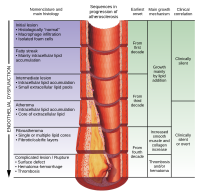
Photo from wikipedia
Atherosclerosis is a chronic inflammatory disease involved in plaque rupture, stroke, thrombosis, and heart attack (myocardial infarction), which is a leading cause of sudden cardiovascular events. In the past decades,… Click to show full abstract
Atherosclerosis is a chronic inflammatory disease involved in plaque rupture, stroke, thrombosis, and heart attack (myocardial infarction), which is a leading cause of sudden cardiovascular events. In the past decades, various imaging strategies have been designed and employed for the diagnosis of atherosclerosis. Targeted imaging can accurately distinguish pathological tissues from normal tissues and reliably reveal biological information in the occurrence and development of atherosclerosis. By taking advantage of versatile imaging techniques, rationally designed imaging probes targeting biomarkers overexpressed in plaque microenvironments and targeting activated cells by modifying specific ligands accumulated in lesion regions have attracted increasing attention. This Perspective elucidates comprehensively the targeted imaging strategies, current challenges, and future development directions for precise identification and diagnosis of atherosclerosis, which is beneficial to better understand the physiological and pathological progression and exploit novel imaging strategies.
Journal Title: Analytical chemistry
Year Published: 2022
Link to full text (if available)
Share on Social Media: Sign Up to like & get
recommendations!